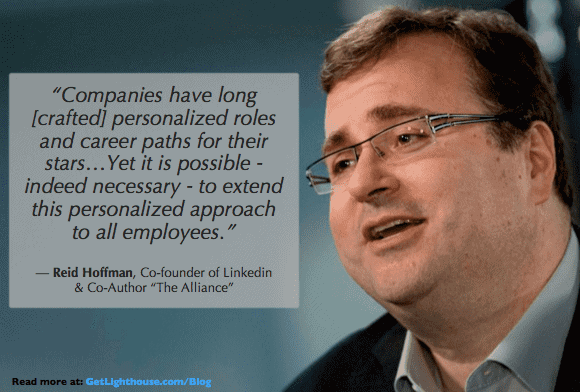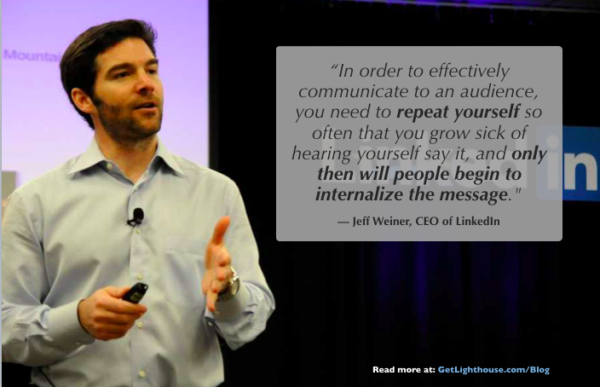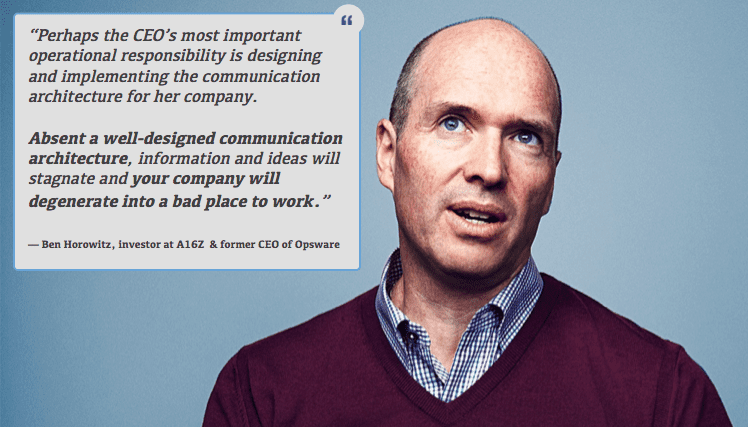Congratulations! Your company is growing and you've hired a great team. They've helped take your fledgling idea and make it more than just a reality, but a bonafide business with revenue that requires commas, an office, and passionate, happy customers.
Unfortunately, the hard work is just beginning. As a wise founder friend once told me, "every year is hard; just the challenges are different."
I've spoken to thousands of leaders and managers as we've started Lighthouse and one common pattern we've found is somewhere around 25 employees, everything breaks. If you're a particularly skilled founder, you may not see these company growth problems until almost 40 employees, or if you're a first timer, some of these organizational challenges could strike as early as 10-15 employees.
Regardless of when these problems strike your business, the key is to realize that managing company growth problems is all about how you handle them. Even the best companies have problems, and with small, incremental progress to make things better, your company's engine (your people) will continue humming.
The first step to fixing a problem is to identify it and its causes, so let's look at why this happens at this stage of company growth.
Company Growth: Why Everything Breaks at 25 Employees
At first, this title may seem a bit sensational, but if you've been there...or you're there now, you know the unique pain of scaling.
Unfortunately, what worked when you all fit around a table, doesn't work when you grow beyond that size. It affects you in all kinds of ways, which is why we're distilling the key patterns and what to do about these common problems today.
Table of Contents:
- Company Growth Problem #1: You can't manage everyone yourself anymore
- Company Growth Problem #2: Everyone doesn't know what's going on anymore
- Company Growth Problem #3: People start caring about their careers
- Company Growth Problem #4: Culture starts to solidify
- How can you navigate these challenges as your company grows?!? A few things can help:

Company Growth Problem #1: You can't manage everyone yourself anymore.
As the image above so clearly shows, you cannot avoid the complexities or adding more people to your company. Every person you add actually grows your lines of communication geometrically.
Most importantly, this becomes a reporting structure issue for your company.
Even with a co-founder or two evenly dividing your team, you still each have 10-15 people to manage. That's too much for someone in a larger organization, let alone someone balancing founder responsibilities.
And if your departments are unbalanced, you may have a single person trying to manage as many as 20 of those people. The dream of a totally flat organization is over as it's impossible to give people the attention they deserve at this stage of company growth.
Unfortunately, that lack of attention comes back to bite you. Problems start to fester and grow and you often start finding out about them when they're at a point you have to triage. Getting into a reactive management mode is how a promising business goes sideways fast.
This can lead to employee turnover (which you can't afford at this stage), a drop in morale, and resentment by team members as they watch the problems grow with no one doing anything about them.
The only way to start getting in front of all these problems is to get help from your people to identify and address these issues without you being the bottleneck. That usually necessitates promoting your first set of people to management roles.
Further Reading:
Ready to start promoting people to management, or mentoring people to get them ready? Here's where to start:
- Learn how to develop leaders as your team grows too big (which will then work for your next stage of growth when your managers are overwhelmed, too)
- Learn the key reasons to promote from within and avoid these 10 pitfalls with promoting from within.
- Make sure you set your managers up for success. Avoid these mistakes that cause new managers to fail, and learn how to set them up for success here.

Company Growth Problem #2: Everyone doesn't know what's going on anymore.
When you all fit around a single table (or a single Google Hangout) it's easy for everyone to feel like they know what's going on. Most people were probably wearing multiple hats and in constant communication as you focused on a single, core thing your business tries to do well.
But now things, have changed. Not only do people wear fewer hats, you probably even have multiple people to do many of the jobs.
Gone are the days when you can have a team wide standup and someone can monitor your wiki and a project management tool to understand what everyone is doing.
Instead, now people have to learn to focus on what they need to do, learn when and whom to reach out to, and trust that everyone else will do the same. This can be especially difficult for your earliest team members who may fondly remember the early days when they were involved in everything.
And this concept is an important meta-lesson, too. The reason everything breaks is not anyone's fault. You didn't make any mistakes as a leader, and neither did your team.
However, in order for you to grow and succeed at your new company size, you have evolve and change how you do things.
It's very efficient for you to talk to 3 people around a table or on a call and we all know what's going on. In contrast, you can't have 30 conversations, nor does a standup with 30 people work. That's why suddenly, you have to start having mini-departments, team leaders, and create a variety of new communication mediums to keep everyone in the loop.
Further Reading:
One of the best things you can do at this stage is embrace organizational communication as a key responsibility for you. Get out in front of it with some of these lessons:
- Learn all about organizational communication from a variety of great sources thanks to Evergreen here.
- Learn how to fix common organizational issues.
- With remote work the norm now, becoming great at asynchronous communication is key, which you can learn how to do here.

Company Growth Problem #3: People start caring about their careers.
When you start out, the people that work for you are often passionate believers who are just trying to help the business succeed. Their career is the success of your business.
Yet, something funny happens around employee 25; both the people that are joining, and often some of the people that have been with the company for quite some time, start asking about their career paths at your company.
They want to know both what opportunities for growth there are and the possibilities for promotion. They want to understand the steps it will take to get there.
You have to pay attention. As Jason Lemkin, VC and former CEO of EchoSign writes:
"It's your job to understand the career path for at least your first 50 employees. Know it. And do whatever you can, within the boundaries of reality, to help them achieve it….Because there's absolutely, positively, nothing worse in the pre-Scale days than losing a rockstar employee that you could have kept. It just kills you.”
If you're not asking, you won't know.
You and the managers you promote or hire need to take seriously discussions about career growth for every single one of your team members.
Otherwise, you'll wonder why you can't retain anyone past 18-24 months and constantly lose internal knowledge and company history with their departures.
Further Reading:
Not sure how to have career conversations with your team members nor what to tell your managers to do? Start here:
- Learn how to help your team achieve their goals and have a great career conversation with everyone here.
- You can't promote everyone, but you absolutely can provide employee development and growth to everyone in your company by applying these tactics.
- Your managers need a growth plan, too. Here's the best professional development goals for your managers.
Company Growth Problem #4: Culture starts to solidify.
As Joe Gebbia, co-founder of Airbnb, recalls learning from Tony Hsieh in the video above: culture is like concrete.
When it is first laid out, it is malleable and can take many shapes. However, after some time, it will harden and then it's very hard to change.
By the time you have 100s or 1,000s of employees, it's too late. You have the culture you're going to have, for better or worse.
Reflect and starting asking yourself tough questions
What are the habits everyone follows? How do you celebrate wins? (Do you?) How are failures handled? What does the team do to find joy in their work? How do you communicate? Are problems resolved or swept under the rug?
By the time you hit 25 employees, like concrete, your culture starts to set. Those behaviors that are answers to those questions are now routines and new employees will start to follow the norms they see, following the "when in Rome..." philosophy ("...do as the Romans do.") and here about how certain things are "that way" here.
If you're not intentional about it, a culture will develop anyways. It just won't be a good one. As Marc Andreesen of A16Z writes:
"It takes time for the culture of any company to become "set" -- for the team of people who have come together for the first time to decide collectively what they're all about, what they value -- and how they look at challenge and adversity.
In the best case, you get an amazing dynamic of people really pulling together, supporting one another, and working their collective tails off in pursuit of a dream.
In the worst case, you end up with widespread, self-reinforcing bitterness, disillusionment, cynicism, bad morale, contempt for management, and depression.”
It takes hard work to build a company people want to work for and that functions at a high level. You have to invest in it, and it's a lot more than perks like free lunches and beers on Fridays.
Further Reading:
Ready for some serious self-reflection and hard work to work on your culture and understand what you want to reinforce and what to change before it's too late (and you end up like Uber, WellsFargo, or Zenefits):
- Ask these questions of yourself to see how your culture is.
- Beware these pitfalls so common to bad Silicon Valley startup cultures.
- Learn from Netflix's first People leader, Patty McCord, about how Netflix made such a great culture.
- Learn the 5 most common ways Founders mess up their culture and how to fix these issues,
- If you know you need to change the culture on your team, start here.
How can you navigate these challenges as your company grows?!? A few things can help:

1) Ensure everyone has one-on-ones.
You need to keep a pulse on your company, so checking in with everyone at least once a quarter as you grow can really help. Unfortunately, even checking in that infrequently eventually becomes unmanageable.
As your company grows, your people need more attention than you can give them yourself, which is why developing leaders in your organization is so important.
Your first wave of leaders, your first layers of managers, need to emerge at this time so they can start taking care of your people working so hard to make the company succeed.
And the single best tool for any leader is the one-on-one. As former Intel CEO Andy Grove says,
"Ninety minutes of your time can enhance the quality of your subordinate's work for two weeks, or for some eighty-plus hours.”
That's a pretty good ROI, right?
Now, if you're making this investment in one-on-ones for the first time, realize they may start out awkward. I've seen it over and over again with managers with their teams; to suddenly be asked what's important to them and what's bothering them can initially be met with distrust.
However, if you and your leaders show you care and follow through on what's discussed, they only get better and better. They'll start coming to you with problems, asking for what they want and need, and answering your questions you ask in 1 on 1s.
If you're promoting from within, this often means having first time managers leading. Give them the tools they need to lead well and be sure you're setting the right example, because remember, culture starts with the example you set.
Further Reading:
Making 1 on 1s a religion like David Cancel, CEO of Drift, does, will pay huge dividends. Here's some places to start if you need help with them:
- Read our ultimate guide to 1 on 1s with the 1 on 1 meeting template great managers use

2) Over-communicate, Over-communicate, Over-communicate.
One of the hardest lessons I find all new leaders struggle with is repetition. New leaders think you can say something once and everyone will get it.
Unfortunately, that's far from true.
You have to repeat yourself a lot more than you think so ideas sink in. Remember, even if you say something 25 times, it might be everyone else has only heard it once. You'll know you've said it enough when they finally start saying it without your prompting.
In an interview with Business Insider, Linkedin CEO Jeff Weiner put it best:
"You invest very heavily and thoughtfully in deciding what kind of company you want to be. And then you repeat it, over and over and over again.
A friend of mine once paraphrased David Gergen, saying on the subject of repetition, "If you want to get your point across, especially to a broader audience, you need to repeat yourself so often, you get sick of hearing yourself say it. And only then will people begin to internalize what you're saying."
And research shows the results are there as well; research written in the Harvard Business Review found:
"Managers who were deliberately redundant moved their projects forward faster and more smoothly."
A follow up email or post in Slack to reinforce what you said in a meeting is a really good idea. In fact, any way you can think to repeat yourself in different ways is going to help: say it in an all hands, write it in an email, talk about it in a presentation, reward someone for living the value, call it out in Slack, etc.
Along with reinforcing actions and values you want to see everyone live out, you also have to look how you can keep people feeling connected to your company's big vision.
The bigger your company grows, the easier it is to feel like your work doesn't have the impact it once did. If you can still help everyone feel like they're contributing something important, they'll follow you to the ends of the earth.

3) Find and Recognize Small Wins.
The more your company grows, the easier it will become for individual contributions to be overlooked. It's also easier for people to feel like a cog in the machine and that their work doesn't matter.
To fight this, look for small wins and regular progress they can make that matters. As researcher and psychology PhD Teresa Amabile reported in the Harvard Business Review:
"Of all the things that can boost emotions, motivation, and perceptions during a workday, the single most important is making progress in meaningful work.
And the more frequently people experience that sense of progress, the more likely they are to be creatively productive in the long run."
Who doesn't want that?
For both you and the leaders in your company, it's important to keep the idea of progress for everyone top of mind.
Some good ways you can do that include:
- Recognizing key wins to remind people leaders notice their work and it matters.
- Making sure no one gets stuck on projects that never end.
- Look for incremental wins to celebrate internally when there are unavoidable big projects.
- Break big problems and projects into smaller, more quickly achievable pieces to keep momentum as much as possible.
- When they come to you with something bothering them, look for something, anything, you can do to show them action is happening to address it.
No matter how you approach praising and helping your team make progress, realize that the bigger your company gets, the more resistance to progress there will be.
More communication, more meetings, more politics, more people you need buy in from, etc all combine to make it harder to make progress. As a founder or senior leader, you have to help fight this by looking for friction and barriers to progress.
Then, help remove them as much as you can. It's the best way to avoid frustrating good people, and ensure your company continues to be productive as you scale.
Further Reading
Thinking about how to help your team make progress or want to get better at building a culture around giving praise? Start here:
- Learn more about the importance of progress and other ways to motivate your team inexpensively here.
- Read our comprehensive guide to praise and bringing more positivity to your team and company here.

There is always another stage of company growth to master.
This is the first of many times where your company growth will cause things to break. As you continue reach new growth stages, things will keep changing, revealing new challenges and requiring doing things differently than you did before.
A good rule of thumb is the rule of 3 and 10 coined by Hiroshi Mikitani, the CEO of Rakuten, the Japanese retailer, as recalled by Evernote founder Phil Libin on the Sequoia Capital blog:
"...when there are 10 people it's all going to change...when there are 30 people it will change again. Same when you reach 100 people.
At every one of those steps everything kind of breaks. Everything. Your communication systems and your payroll and your accounting and customer support. Everything that you put into place needs to change when you put in those 3 and 10 steps."
If you can recognize and embrace this now, you'll save you and your team a lot of pain later. Just like you repeat values to reinforce them, you can teach your team to embrace change, too.
Let them know there are no sacred cows as you ride the waves of new growth stages in your company. Lean into these changes and look for ways to make the necessary changes as smoothly as you can.

What is Company Growth?
Company growth is when you hire more employees for your company or add more revenue. Both are good signs for the prospects of your company, but having more employees presents new challenges.
What is a growth stage company?
A growth stage company is one that has reached some level of product market fit and is starting to sell or market its product successfully to a healthy market. When a company reaches this stage, they start to move beyond a "whatever it takes", hustling culture and starts to have to establish new processes, teams, and ways of doing things.






